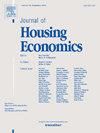Inclusive growth or displacement? Examining upzoning and gentrification in Lahore, Pakistan
IF 2.4
3区 经济学
Q3 ECONOMICS
引用次数: 0
Abstract
This paper presents the first impact evaluation of recent upzoning reforms in Lahore, Pakistan - a megacity with a population of approximately 13 million. Leveraging data from Pakistan’s largest online property platform and nationally representative labor force surveys, we provide causal evidence that the 2020 policy reform permitting vertical development led to a significant increase in property prices within upzoned areas. Specifically, we find that upzoning increased property prices by at least 8.4 percent after controlling for unobserved heterogeneity within the city and hedonic attributes of properties. We also find compelling evidence of gentrification in upzoned neighborhoods: the likelihood of residents with higher wages, being literate, and having completed higher education increases as a result of upzoning. While upzoning does not affect the probability of working, it does increase the probability of working as a professional/manager or being employed in the tertiary sector. These patterns point to a marked shift in the socioeconomic composition of upzoned areas, aligning with the broader literature on gentrification as an unintended consequence of relaxation in land-use regulations. The effects of upzoning appear to be geographically contained, with no evidence of spillovers into adjacent areas. Owing to the inelastic nature of housing supply and data constraints, the study does not evaluate the policy’s effect on housing stock expansion. Nevertheless, this study offers novel evidence from a developing country context, where empirical research on upzoning remains scarce. The findings have important implications for housing affordability policy and the design of complementary public infrastructure to support upzoning reforms.
包容性增长还是替代?考察巴基斯坦拉合尔的分区升级和中产阶级化
本文首次对巴基斯坦拉合尔(一个人口约为1300万的特大城市)最近的分区升级改革进行了影响评估。利用巴基斯坦最大的在线房地产平台和具有全国代表性的劳动力调查数据,我们提供了因果证据,证明2020年允许垂直发展的政策改革导致区划区域内房地产价格大幅上涨。具体来说,我们发现,在控制了城市内部未观察到的异质性和房产的享乐属性之后,升级分区使房地产价格至少上涨了8.4%。我们还发现了分区升级社区中产阶级化的令人信服的证据:由于分区升级,居民收入更高、识字、完成高等教育的可能性增加。虽然分区升级并不影响工作的可能性,但它确实增加了成为专业人士/经理或受雇于第三产业的可能性。这些模式表明,分区后地区的社会经济构成发生了显著变化,这与更广泛的文献一致,即土地使用法规放松的意外后果是中产阶级化。分区升级的影响在地理上似乎是可控的,没有证据表明它会溢出到邻近地区。由于住房供应的非弹性和数据的限制,本研究没有评估政策对住房存量扩张的影响。然而,本研究提供了来自发展中国家背景下的新证据,在发展中国家,关于升级的实证研究仍然很少。研究结果对住房负担能力政策和配套公共基础设施的设计具有重要意义,以支持分区升级改革。
本文章由计算机程序翻译,如有差异,请以英文原文为准。
求助全文
约1分钟内获得全文
求助全文
来源期刊

Journal of Housing Economics
Multiple-
CiteScore
3.30
自引率
4.20%
发文量
35
期刊介绍:
The Journal of Housing Economics provides a focal point for the publication of economic research related to housing and encourages papers that bring to bear careful analytical technique on important housing-related questions. The journal covers the broad spectrum of topics and approaches that constitute housing economics, including analysis of important public policy issues.
 求助内容:
求助内容: 应助结果提醒方式:
应助结果提醒方式:


